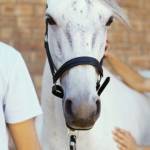Farm Hygiene Important for Horse Biosecurity

Everyone knows hygiene starts with the hands. Reminders to wash your hands are posted all over restaurants, the workplace, and doctors’ offices. Yet in one recent study*, nearly 400 individuals associated with agriculture said one of the biggest challenges to disease control on farms is lack of access to soap and water to wash their hands.
Although the word “biosecurity” may conjure images of the Centers for Disease Control, it simply refers to the procedures designed to protect a specific population against harmful biological or biochemical substances.
Horse farms are often busy places with veterinarians, delivery personnel, clients/boarders, farriers, and other people coming and going frequently. Thus, implementing and maintaining adequate biosecurity to protect horses from a wide range of communicable diseases is imperative. (Examples of such diseases include ringworm, salmonellosis, strangles, methicillin-resistant Staphylococcus aureus, and other gastrointestinal and respiratory diseases.) Of the farms in the study, however, horse farms had markedly fewer biosecurity protocols in place than other animal operations, such as pig and cattle farms.
How can we remedy this situation? Consider some of these basic recommendations made by the Swedish researchers:
- Provide protective clothing in various sizes (including boots) to visitors, or request visitors provide their own change of clean clothing and footwear, especially for individuals who travel frequently between horse farms;
- Offer water, soap, a wash basin, and paper towels on every farm; and
- Create a space where boots and equipment can be hosed off.
Other recommended biosecurity measures for equine farms include isolating newly introduced horses before mixing with the general population, taking horses’ temperatures to monitor for disease, and recording vaccine and deworming history for all horses on the farm.
The study also outlined commonly cited reasons for poor biosecurity measures: complacency in the face of infrequent disease outbreaks and the lack of knowledge about certain diseases. Thus, clear lines of communication between farm operators/horse owners and their veterinarians is needed to maximize the health and safety of horses.








